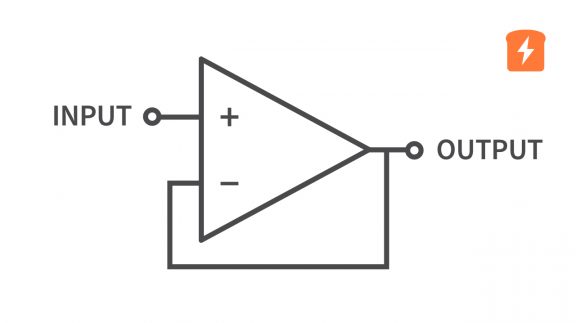Op-amp Inverting and Non-inverting Circuits
Published
Perhaps unsurprisingly, given their name, operational amplifiers are very often used in amplifying circuits. They are put together in either an inverting or non-inverting configuration, a concept we’ll cover momentarily, and the amount of amplification can be carefully controlled.

Before jumping into these configurations, let’s address an important topic. If you have been going through these tutorials, you will note that sometimes the input marked “+” is sometimes referred to as positive and other times as “non-inverting”. Then the input marked “-” is sometimes referred to as negative and other times as “inverting”. In reality, using the terms “positive” and “negative” are arguably incorrect and, at best, are misleading. They’re a lot easier to use, though, which is why they’re so prevalent. The true difference between the inverting and the non-inverting inputs is which way the output swings with the voltages on the inputs. If the non-inverting input is at a higher voltage than the inverting input, then the output will go high. If the inverting input is higher than the non-inverting input, then the output will go low (which can be negative, depending on the configuration of the op-amp). This will be covered again, and in more depth, in the op-amp comparator tutorial, but this is sufficient for understanding this tutorial.
Inverting Op-Amp Circuit
As it is more common, we’ll go over the inverting op-amp circuit first. The circuit setup looks like this:

Remembering the Golden Rules of Op-amps, or the 2 most important things to remember with op-amps, we can see that:
- the inverting input is at a virtual ground as the non-inverting input is tied to ground, and
- that the same current through Ri is going through Rf.
To help remember what the letters stand for, Ri is the input resistor, and Rf is the feedback resistor, as the output is driving the input through Rf. Now that we’ve got that in mind, let’s solve this circuit to see if we can find an equation to describe the performance of this circuit mathematically. We can use KCL. Let’s use the inverting input as our node.
We know that current flowing into that node must equal the current flowing out and no current is flowing into the inverting input, so there is only the current coming in via Ri and out via Rf and they are equal to each other. We can then setup the equation as:

or

Now, we want to see what the relationship is between our output and input, a gain or amplification term we’ll call “A” where A = Vout/Vin. Rearranging the equation, we can see the following:

So, whatever voltage you put on the input, the output will be amplified by Rf/Ri and then inverted into a negative voltage. For example, if you have a 10K feedback resistor, and a 2K input resistor, an input voltage of 2V will yield an output voltage of -10V. And this should make sense - for the current to flow from a positive input voltage to the virtual ground and then from the virtual ground to the output, the output voltage *must* be negative! And vice versa if the input is a negative voltage.
This is an extremely common op-amp configuration as most feedback loops utilize negative feedback, as that increases stability and reduces distortion. This is outside the scope of this tutorial, but Kushal discusses it in his control systems tutorials.
Non-Inverting Op-Amp Circuit
For a non-inverting circuit, you don’t simply swap the connections between the inverting and non-inverting inputs. The circuit is slightly different.

As expected, the signal input is to the non-inverting input, but now the inverting input is in the middle of a voltage divider. As the output is now connected to the inverting input via that voltage divider, we know that it will drive the inverting input to match that of the non-inverting input. Let’s see how the Golden Rules of op-amps applies in this case.
- the inverting input is being driven to be the same voltage as the non-inverting input, and
- that the same current through R1 is going through R2.
Once again, we can describe the behavior of this circuit mathematically using KCL. Selecting the inverting input node, we come up with the following equation:

or

This can be simplified by multiplying both sides by R2 and dividing both sides by Vin:

This separates out to:

And finally, adding one on each side:

Our gain, or amplification amount, again being designated as “A” gives us:

There were a few more steps in that calculation versus the inverting amplifier but still nothing too difficult as long as you don’t miss a step. But let’s look at this as well. Imagine you have that same 2V input that we used with the inverting op-amp and the same 10K and 2K resistors, for R2 and R1 respectively. In this case, you’d get a gain of 6 (10K/2K + 1), so your output voltage would be 12V. A negative input voltage would also yield a negative output voltage.
Again, non-inverting op-amp amplifier configurations are not as common but they’re still very useful and you’ll definitely come across them.
Summary
These two configurations are great not only because they are legitimately useful and can be found in the wild in many different applications but also because they help us become more familiar with how an op-amp works. Using them, doing these calculations, help us get a better intuitive feel for what will happen with an op-amp in a circuit. I hope that this overview was clear - if not, leave a comment below and we’ll try and resolve any questions. Go check out some of the practice problems for op-amps on YouTube here: Operational Amplifier (Op-Amp) Practice Problems and be sure to familiarize yourself with the other op-amp configurations as we get them up here on CircuitBread.

Get the latest tools and tutorials, fresh from the toaster.














